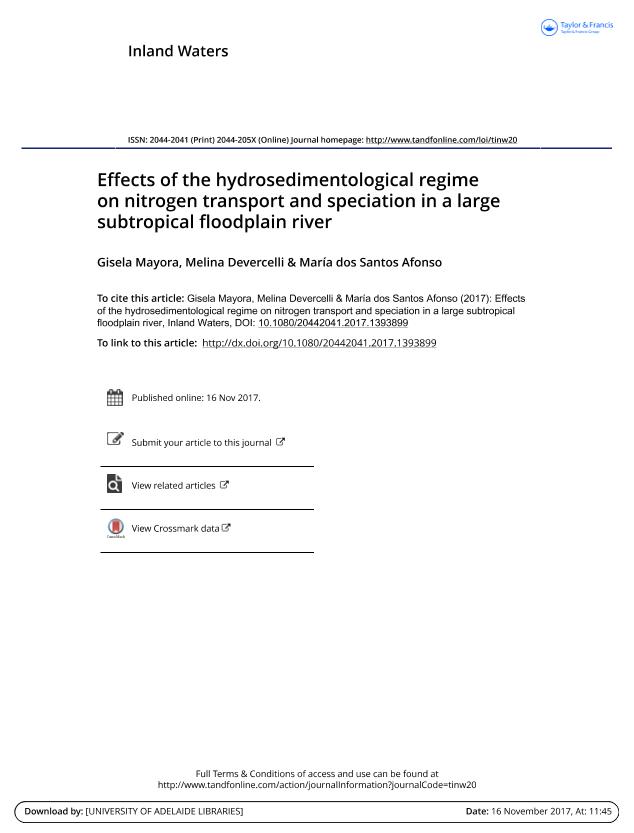Mostrar el registro sencillo del ítem
dc.contributor.author
Mayora, Gisela Paola

dc.contributor.author
Devercelli, Melina

dc.contributor.author
Dos Santos Afonso, María

dc.date.available
2018-09-17T15:25:09Z
dc.date.issued
2017-11
dc.identifier.citation
Mayora, Gisela Paola; Devercelli, Melina; Dos Santos Afonso, María; Effects of the hydrosedimentological regime on nitrogen transport and speciation in a large subtropical floodplain river; Taylor & Francis; Inland Waters; 7; 4; 11-2017; 461-472
dc.identifier.issn
2044-205X
dc.identifier.uri
http://hdl.handle.net/11336/59861
dc.description.abstract
Hydrosedimentological conditions of floodplain rivers can affect nutrient delivery processes. This study aimed to evaluate the effects of sedimentological and hydrological regimes on N speciation and transport in the floodplain-river system of the Middle Paraná. Relations of sedimentological and hydrological regimes, assessed through turbidity and hydrometric level, with N speciation and concentration were analyzed. Simple linear regressions were performed to assess whether N load changed within the main channel in response to hydrological and sedimentological regimes. From the main channel to the floodplain, dissolved inorganic N decreased. However, the most isolated lake had the highest N concentration, almost totally in organic form. Turbidity was negatively associated to concentrations of nitrate-N (N-NO3-), nitrite-N (N-NO2-) and dissolved organic N (DON), and relative contributions of these N forms to total N (TN). Contrarily, it was positively correlated to particulate N (PN) and ammonium-N (N-NH4+). Hydrometric level was positively associated to DON concentration and its relative contribution at the main channel; but negatively associated to DON, PN and TN concentrations in the most isolated lake. Simple linear regressions showed that the sedimentological regime explained significantly all N forms, but not TN load. The flood increased TN and mainly DON load. The results show that the hydrosedimentological regime largely affects N transport and speciation. The sediment peak incorporates PN to the system and affects dissolved N speciation probably through effects of suspended particles on redox reactions. The increase of N inputs to the fluvial system during the flood could be caused by DON exportation from the floodplain.
dc.format
application/pdf
dc.language.iso
eng
dc.publisher
Taylor & Francis
dc.rights
info:eu-repo/semantics/openAccess
dc.rights.uri
https://creativecommons.org/licenses/by-nc-sa/2.5/ar/
dc.subject
Hydrological And Sedimentological Fluctuations
dc.subject
Middle Paraná River
dc.subject
Nitrogen Forms
dc.subject
Nitrogen Load
dc.subject
Spatial Gradient
dc.subject.classification
Meteorología y Ciencias Atmosféricas

dc.subject.classification
Ciencias de la Tierra y relacionadas con el Medio Ambiente

dc.subject.classification
CIENCIAS NATURALES Y EXACTAS

dc.title
Effects of the hydrosedimentological regime on nitrogen transport and speciation in a large subtropical floodplain river
dc.type
info:eu-repo/semantics/article
dc.type
info:ar-repo/semantics/artículo
dc.type
info:eu-repo/semantics/publishedVersion
dc.date.updated
2018-09-14T13:25:47Z
dc.journal.volume
7
dc.journal.number
4
dc.journal.pagination
461-472
dc.journal.pais
Reino Unido

dc.journal.ciudad
Londres
dc.description.fil
Fil: Mayora, Gisela Paola. Consejo Nacional de Investigaciones Científicas y Técnicas. Centro Científico Tecnológico Conicet - Santa Fe. Instituto Nacional de Limnología. Universidad Nacional del Litoral. Instituto Nacional de Limnología; Argentina
dc.description.fil
Fil: Devercelli, Melina. Consejo Nacional de Investigaciones Científicas y Técnicas. Centro Científico Tecnológico Conicet - Santa Fe. Instituto Nacional de Limnología. Universidad Nacional del Litoral. Instituto Nacional de Limnología; Argentina
dc.description.fil
Fil: Dos Santos Afonso, María. Consejo Nacional de Investigaciones Científicas y Técnicas. Oficina de Coordinación Administrativa Ciudad Universitaria. Instituto de Química, Física de los Materiales, Medioambiente y Energía. Universidad de Buenos Aires. Facultad de Ciencias Exactas y Naturales. Instituto de Química, Física de los Materiales, Medioambiente y Energía; Argentina. Universidad de Buenos Aires. Facultad de Ciencias Exactas y Naturales. Departamento de Química Inorgánica, Analítica y Química Física; Argentina
dc.journal.title
Inland Waters
dc.relation.alternativeid
info:eu-repo/semantics/altIdentifier/doi/https://dx.doi.org/10.1080/20442041.2017.1393899
dc.relation.alternativeid
info:eu-repo/semantics/altIdentifier/url/https://www.tandfonline.com/doi/full/10.1080/20442041.2017.1393899
Archivos asociados
